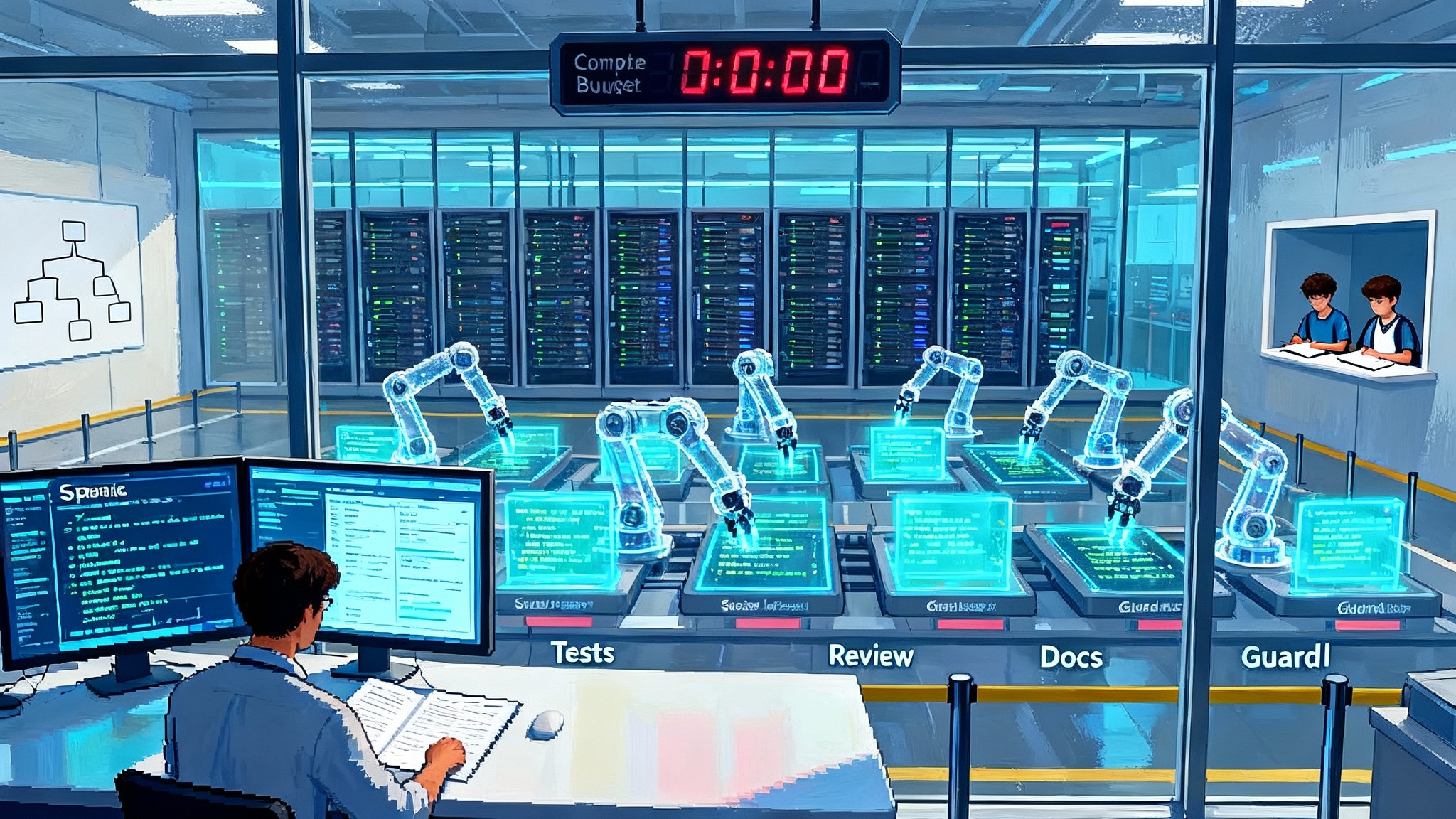From Rules to Rails: Europe Builds Public AI Infrastructure
In one October week, Brussels moved from writing AI rules to building the rails that make them real. Explore the EU Apply AI push, why it matters, and a 180 day U.S. playbook for competitive, safe adoption at scale.

The week Europe shifted from rules to rails
In the span of three days in early October 2025, Brussels signaled a strategic pivot. On October 8, 2025, the European Commission introduced the Apply AI Strategy and new governance machinery to make it stick. The package couples policy with operating detail: an Apply AI Alliance for ongoing coordination and an AI Observatory to watch the market, measure impact, and update course. This is not another white paper. It is the blueprint for turning law into public infrastructure, complete with officials, processes, and service desks that lift adoption rather than just set guardrails. The Commission framed it as the move that takes Europe from principle to practice, and did so in public view through the Apply AI Strategy and Alliance.
Two days later, on October 10, 2025, the Commission added concrete where the plans meet power. It expanded the EU network of AI Factories, adding six more sites to provide startups, small and medium sized enterprises, researchers, and public agencies with access to AI tuned supercomputers, talent, and technical support. The new wave brought the network to 19 AI Factories across 16 Member States, backed by more than 500 million euros from the Union and national governments. The announcement was not framed as chips and compute alone. It underscored a federated service model for onboarding, training, testing, and deployment. Think of it as standardized stations on a continental rail system, not isolated server rooms. The Commission detailed the move in a press release that expanded the AI Factories network.
With those two steps, Europe made a clear bet: the next competitive era belongs to states that act like systems integrators. Rules matter, but rails carry the load.
Policy as infrastructure, not just law
When policymakers say infrastructure, people picture roads and power lines. Digital infrastructure is similar, only the lanes are procurement templates, conformance tests, onboarding portals, and shared compute. Europe’s Apply AI push turns what used to be informal guidance into services you can log into, hardware you can schedule, and processes you can pass or fail.
A helpful analogy comes from the early internet. The shift from ad hoc connections to standardized Internet Exchange Points lifted entire regions. It reduced friction and encoded the norms that turned local networks into the internet. Apply AI tries to do the same for artificial intelligence. It offers common stations and signals so that thousands of projects can move safely, quickly, and in the same direction.
In practical terms, that means:
- Clear staging areas. AI Factories function as one stop shops, where a company can request compute, technical support, and training, rather than hunt through fragmented programs.
- A living map. The AI Observatory aggregates metrics on supply, demand, and workforce, then feeds those numbers back into policy iteration.
- A coordination layer. The Apply AI Alliance convenes industry, agencies, researchers, unions, and civil society into a single operating forum, replacing sporadic consultations with a standing table.
- A service desk. The AI Act Service Desk gives implementers somewhere to ask how a rule applies, and to get an answer that becomes precedent for others.
Each piece converts abstract policy into operating rails. Those rails lower friction and make safe adoption the default path, not a bespoke project.
What public AI rails actually look like
If you need a more concrete picture, imagine a hospital that wants to roll out a triage assistant for emergency rooms:
-
Identity and access. The project uses a national identity token and a hospital directory to ensure only licensed staff can access the assistant. No custom login systems, just a certified connector.
-
Data rights. The hospital joins a health data space that standardizes patient consent flows and audit trails. The rails include a data contract template so the hospital knows what it can ingest, what it must mask, and what it must log.
-
Compute and tooling. The team books training and evaluation time through the nearest AI Factory. The reservation includes optimized libraries, model cards, and compliance logging out of the box.
-
Testing and red teaming. Before deployment, the assistant passes a published evaluation suite for high risk clinical tools. The test targets known failure modes and records performance benchmarks that regulators and insurers accept.
-
Procurement and liability. The hospital uses a pre cleared procurement pathway that embeds the required model documentation and post market monitoring plan. After it passes conformance tests, the project qualifies for a safe harbor on certain liability exposures, contingent on continuous logging and a prompt reporting window.
-
Monitoring and feedback. The AI Observatory collects anonymized, sector level performance and incident data. When patterns emerge, the conformance suite updates, and everyone inherits the fix.
These steps feel unglamorous compared with a splashy new model, yet they are exactly what unlock responsible scale. Rails shorten cycles, reduce legal ambiguity, and provide shared measurements.
Why rails accelerate safe adoption
Rails do three things at once.
- They reduce setup cost. Common templates and portals replace bespoke legal work and tooling. The marginal project rides on previous projects’ answers.
- They align incentives. When evaluations, procurement, and reimbursement keys are attached to conformance, every actor wants to pass the test, not just claim they tested.
- They create compounding benefits. Incidents or improvements in one sector translate into updated rail components for all. You do not just learn faster, you distribute the learning faster.
This is how industries leap. Payments did it with standard rails like the Single Euro Payments Area. Telecommunications did it with spectrum policy and standardized roaming. If artificial intelligence is to reach every sector, it needs the same predictable paths and handoffs. For a deeper look at why infrastructure changes market behavior, see how compute as the new utility rewires incentives from the bottom up.
The power shift: from platform dominance to policy driven infrastructure
Platform monopolies thrive on control of critical chokepoints such as distribution and developer ecosystems. Public rails change the bargaining power. When a model provider plugs into government run conformance tests and shared onboarding, customers can switch providers that meet the same standards. That lowers lock in while raising the bar for everyone. It does not eliminate commercial advantage. It moves advantage from exclusive control to demonstrable performance on public tests and interoperability under public rules.
This is not anti business. It is pro contestability. The winners are the companies that ship fast within these rails, and the governments that maintain them well. A national utilities metaphor fits. No one expects a private generator to also own the grid operator, the line standards, and the inspection regime. The grid sets the rules and interconnection tests so that many generators can deliver power safely. Apply AI is the grid operator for artificial intelligence.
Where the rails will be most decisive
- Health. Pre certification pathways and shared audit standards will determine which triage, imaging, and scheduling tools hospitals can deploy, insure, and reimburse.
- Public services. Agencies will favor models and applications that pass the AI Act conformance and logging requirements, as well as accessibility tests. Procurement templates will become the gateway to public sector scale.
- Small and medium sized enterprises. With AI Factories providing compute credits, training, and support, small manufacturers and farms can adopt agentic automation without renting entire machine learning teams. This is where the good enough frontier becomes practical policy, not just a technical trend.
- National security and resilience. Shared evaluation batteries and model registries make it easier to adopt decision support tools that meet stress tested thresholds, and to revoke or quarantine models that fail.
Open questions for Europe
Europe now has to prove that the rails run on time. Three challenges stand out:
- Throughput and uptime. Can AI Factories deliver predictable queue times and service quality during peak demand, and will the procurement rails avoid becoming a bottleneck?
- Cohesion across Member States. The framework is European, but service delivery will vary locally. Consistent conformance outcomes are essential, or firms will shop for the easiest jurisdiction and fragment the market.
- Update cadence. The AI Observatory must translate new technical findings into updated tests quickly, especially as agentic systems evolve. Slow updates will be as dangerous as no updates.
If Brussels gets these right, the rails become a durable advantage rather than a bureaucratic maze.
What a United States response should be, before standards harden
Standards reward early movers. Once conformance suites and procurement pathways become normal in cross border contracts, they shape default behavior globally. The United States still has a window to lead with its own public rails, and to align with European ones where interests converge.
Here is a focused plan for the next 180 days:
-
Create an American AI Rails program with a single owner. Task the National Institute of Standards and Technology to run a permanent conformance program for sector specific evaluations, red teaming protocols, and reference audits. Fund it like an infrastructure agency and require interagency adoption timelines so the tests become operating reality, not guidance.
-
Launch a public option for compute. Use Department of Energy labs and a National Science Foundation backbone to offer reserved capacity for startups, small and medium sized enterprises, and state agencies. Package it with onboarding, training, and toolchains, not just GPU hours. Make entry contingent on logging, evaluation, and disclosure commitments. For the strategic context, connect this to the idea that compute should be treated as a public utility, as explored in compute as the new utility.
-
Stand up a federal model registry and safety case portal. Require vendors selling to the federal government to register model identifiers, training descriptions, known limitations, and evaluation results. Provide a structured safety case format so procurement officers can make apples to apples decisions. Offer an accelerated path to agencies that buy models that pass published tests.
-
Publish a single set of procurement templates. Have the General Services Administration release contracts that package documentation, incident reporting, and post market monitoring into standard clauses. Attach safe harbor liability if vendors meet logging and rapid fix obligations.
-
Make conformance machine readable. Offer a continuous integration and continuous deployment pipeline that vendors can integrate. If a new test is added or updated, models get re evaluated automatically. Publish badges that reflect the date and suite version.
-
Build data spaces in priority sectors. Encourage health, climate, manufacturing, and mobility data spaces with consent and audit built in. Fund connectors for common enterprise systems so small firms can join without custom integration.
-
Align identity and access. Expand Login.gov and Fast Identity Online backed credentials into a standard way to control access to sensitive model actions. Publish a reference design for role based prompts and approvals in high risk workflows.
-
Coordinate with allies on mutual recognition. Push for bilateral agreements where passing one region’s conformance suite satisfies the other’s baseline, subject to a gap addendum. Start with clear areas like model transparency and incident reporting, then add sector tests.
-
Put time bounds on adoption. Set deadlines for agencies to use the rails and to sunset non conformant deployments. The point is to make the rails the easiest way to ship, not an optional extra.
-
Publish a rolling Observatory style dashboard. Track adoption, incident rates, and queue times in public, then use that data to tune funding and staffing.
None of this requires waiting for new laws. It is service design and standards engineering, built on existing authorities. The underlying thesis is simple. If the United States wants a competitive, safe, and pluralistic artificial intelligence market, it should reduce adoption friction and bake in accountability at the infrastructure layer.
How this changes company strategy
If you build models, tools, or applications, the rails change where you compete and how you sell.
- Product. Design to pass public tests. Publish model cards, logs, and red team results in the formats the rails expect. Treat conformance regressions as production outages.
- Go to market. Map your pipeline to the rail steps your customers must pass. If hospitals need a liability safe harbor bundled with logging, ship that first. If public agencies need accessibility and security attestations, make them turnkey.
- Partnerships. Team with integrators who understand the rails. The best partners will be the ones who can shepherd deployments through identity, data rights, and evaluation in one sprint.
- Pricing. Consider conformance based pricing. If you pass a higher level test suite, unlock a preferred rate. Customers will pay for faster approvals and lower risk.
Companies that internalize the rails will ship faster and close more deals. Companies that ignore them will spend months in procurement purgatory.
Safety as a system feature
Public rails do not eliminate incidents. They make incidents legible and fixable. Shared tests and logging turn isolated failures into system learning. That is how aviation became safe. AI needs the same habit of recording, sharing, and improving. For a deeper dive on how this culture takes hold, see why AI is entering an aviation style safety era.
Three practical habits help:
- Treat evaluations like unit tests. Run them in continuous integration, publish summaries, and fail builds that regress.
- Build incident intake into the product. Make it easy for users to report bad outputs and for your team to attach logs that show root cause.
- Automate renewals. When the Observatory or conformance body updates a test, re run and publish the date stamp. Reliability is a moving target.
What to watch over the next year
- Factory throughput. Are AI Factories clearing queues in days or weeks, and do reservations slip during peak periods? The answer determines whether small firms can actually use the rails.
- Cross border consistency. Do identical systems pass or fail depending on the Member State? If outcomes diverge, policy will drift toward the path of least resistance.
- Update speed. How long does it take to add a new evaluation for an emergent failure mode in agentic systems? The calendar tells you how fast the rails learn.
- Procurement velocity. Are public contracts citing the conformance suites, and are award times shrinking as a result? Procurement is the real adoption metric.
- Vendor behavior. Do model providers publish richer documentation and logs to win public sector deals? Watch what moves revenue, not what fills blog posts.
Why this matters now
The longer Europe runs its rails, the more other regions will reference them in tenders and trade language. That is normal. Standards propagate through procurement and finance. Once insurers and banks set underwriting rules that reference a particular test suite, vendors around the world start designing to that suite.
There is a commercial angle as well. Platform companies will still differentiate on models, tooling, and services. Rails do not cap ambition. They create predictable thresholds for performance and safety. Firms that can meet those thresholds fastest will win government and enterprise business in more markets. Firms that cannot will find the market smaller than the hype suggested.
Conclusion: the rails are being laid, choose your junctions
This October was a milestone. Europe put steel into the ground with a strategy that connects governance to compute and to day to day adoption. The continent is not relying on exhortation or one off grants. It is building the boring, necessary parts of scale: queues, checklists, logs, and handoffs. That is how complex systems grow safely.
The choice for others is not whether to copy Europe. It is where to connect to shared ideas and where to diverge with better ones. If the United States wants to shape the junctions, it should show up with rails of its own, soon. The promised future of artificial intelligence will be delivered over whichever tracks are ready. Those laying tracks now will decide how fast, how safe, and for whose benefit the trains will run.








